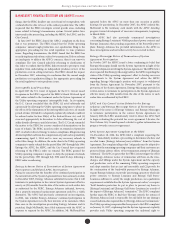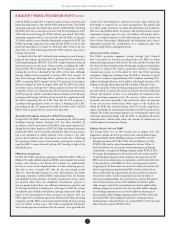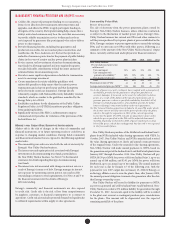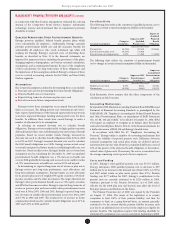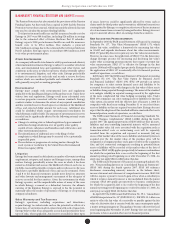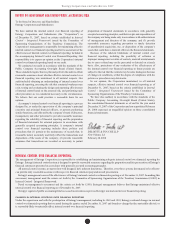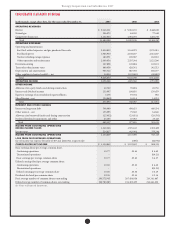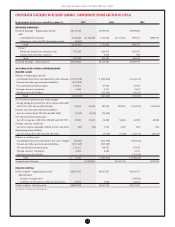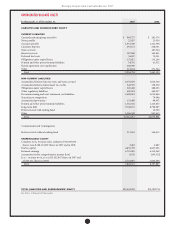Entergy 2007 Annual Report Download - page 50
Download and view the complete annual report
Please find page 50 of the 2007 Entergy annual report below. You can navigate through the pages in the report by either clicking on the pages listed below, or by using the keyword search tool below to find specific information within the annual report.
48
Entergy Corporation and Subsidiaries 2007
Some of the agreements to sell the power produced by Entergy’s
Non-Utility Nuclear power plants contain provisions that require an
Entergy subsidiary to provide collateral to secure its obligations under
the agreements. e Entergy subsidiary will be required to provide
collateral based upon the dierence between the current market and
contracted power prices in the regions where Non-Utility Nuclear sells
power. e primary form of collateral to satisfy these requirements
would be an Entergy Corporation guaranty. Cash and letters of
credit are also acceptable forms of collateral. At December 31, 2007,
based on power prices at that time, Entergy had in place as collateral
$702 million of Entergy Corporation guarantees for wholesale
transactions, including $63 million of guarantees that support letters
of credit. e assurance requirement associated with Non-Utility
Nuclear is estimated to increase by an amount up to $294 million if
gas prices increase $1 per MMBtu in both the short- and long-term
markets. In the event of a decrease in Entergy Corporation’s credit
rating to below investment grade, Entergy will be required to replace
Entergy Corporation guarantees with cash or letters of credit under
some of the agreements.
In addition to selling the power produced by its plants, the Non-
Utility Nuclear business sells installed capacity to load-serving
distribution companies in order for those companies to meet
requirements placed on them by the ISO in their area. Following is a
summary of the amount of the Non-Utility Nuclear business’ installed
capacity that is currently sold forward, and the blended amount of the
Non-Utility Nuclear business’ planned generation output and installed
capacity that is currently sold forward:
2008 2009 2010 2011 2012
Non-Utility Nuclear:
Percent of capacity sold forward:
Bundled capacity and
energy contracts 27% 26% 26% 26% 19%
Capacity contracts 59% 34% 16% 9% 2%
Total 86% 60% 42% 35% 21%
Planned net MW in operation 4,998 4,998 4,998 4,998 4,998
Average capacity contract
price per kW per month $1.8 $1.7 $2.5 $3.1 $3.5
Blended capacity and
energy (based on revenues):
% of planned generation
and capacity sold forward 89% 78% 51% 35% 17%
Average contract revenue
per MWh $56 $62 $59 $56 $52
As of December 31, 2007, approximately 96% of Non-Utility Nuclear’s
counterparty exposure from energy and capacity contracts is with
counterparties with public investment grade credit ratings.
CE N T R A L STAT E S CO M P A C T CL A I M
e Low-Level Radioactive Waste Policy Act of 1980 holds each state
responsible for disposal of low-level radioactive waste originating in
that state, but allows states to participate in regional compacts to fulll
their responsibilities jointly. Arkansas and Louisiana participate in
the Central Interstate Low-Level Radioactive Waste Compact (Central
States Compact or Compact). Commencing in early 1988, Entergy
Arkansas, Entergy Gulf States, Inc. and Entergy Louisiana made
a series of contributions to the Central States Compact to fund the
Central States Compact’s development of a low-level radioactive waste
disposal facility to be located in Boyd County, Nebraska. In December
1998, Nebraska, the host state for the proposed Central States Compact
disposal facility, denied the compact’s license application for the
proposed disposal facility. Several parties, including the commission
that governs the compact (the Compact Commission), led a lawsuit
against Nebraska seeking damages resulting from Nebraska’s denial of
the proposed facility’s license. Aer a trial, the U.S. District Court
concluded that Nebraska violated its good faith obligations regarding
the proposed waste disposal facility and rendered a judgment against
Nebraska in the amount of $151 million. In August 2004, Nebraska
agreed to pay the Compact $141 million in settlement of the judgment.
In July 2005, the Compact Commission decided to distribute a
substantial portion of the proceeds from the settlement to the nuclear
power generators that had contributed funding for the Boyd County
facility, including Entergy Arkansas, Entergy Gulf States, Inc. and
Entergy Louisiana. On August 1, 2005, Nebraska paid $145 million,
including interest, to the Compact, and the Compact distributed from
the settlement proceeds $23.6 million to Entergy Arkansas, $19.9
million to Entergy Gulf States, Inc., and $19.4 million to Entergy
Louisiana. The proceeds contributed $28.7 million in pre-tax income
in 2005.
CRITICAL ACCOUNTING ESTIMATES
e preparation of Entergy’s nancial statements in conformity with
generally accepted accounting principles requires management to
apply appropriate accounting policies and to make estimates and
judgments that can have a signicant eect on reported nancial
position, results of operations, and cash ows. Management has
identied the following accounting policies and estimates as critical
because they are based on assumptions and measurements that involve
a high degree of uncertainty, and the potential for future changes in
the assumptions and measurements that could produce estimates that
would have a material eect on the presentation of Entergy’s nancial
position or results of operations.
NU C L E A R DE C O M M I S S I O N I N G CO S T S
Entergy owns a signicant number of nuclear generation facilities in
both its Utility and Non-Utility Nuclear business units. Regulations
require Entergy to decommission its nuclear power plants aer each
facility is taken out of service, and money is collected and deposited
in trust funds during the facilities’ operating lives in order to provide
for this obligation. Entergy conducts periodic decommissioning cost
studies to estimate the costs that will be incurred to decommission the
facilities. e following key assumptions have a signicant eect on
these estimates:
n COST ESCALATION FACTORS – Entergy’s decommissioning
revenue requirement studies include an assumption that
decommissioning costs will escalate over present cost levels by
annual factors ranging from approximately CPI-U to 5.5%. A 50
basis point change in this assumption could change the ultimate
cost of decommissioning a facility by as much as 11%.
n TIMING – In projecting decommissioning costs, two assumptions
must be made to estimate the timing of plant decommissioning.
First, the date of the plant’s retirement must be estimated. e
expiration of the plant’s operating license is typically used for
this purpose, but the assumption may be made that the plant’s
license will be renewed and operate for some time beyond the
original license term. Second, an assumption must be made
whether decommissioning will begin immediately upon plant
retirement, or whether the plant will be held in “safestore” status
for later decommissioning, as permitted by applicable regulations.
While the eect of these assumptions cannot be determined with
precision, assuming either license renewal or use of a “safestore”
status can possibly change the present value of these obligations.
Future revisions to appropriately reect changes needed to the
Management’s Financial Discussion and Analysis conti nued








